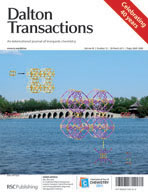Metal-site Trp/His interactions are crucial to diverse metalloprotein functions. This paper presents a study using metal-motif mimicry to capture and dissect the static and transient components of physicochemical properties underlying the Trp/His aromatic side-chain noncovalent interactions across the first- and second-coordination spheres of biometal ions. Modular biomimetic constructs, EDTA-(L-Trp, L-His) or EWH and DTPA-(L-Trp, L-His) or DWH, featuring a function-significant Trp/His pair, enabled extracting the putative hydrophobic/hydrophilic aromatic interactions surrounding metal centers. Fluorescence, circular dichroism (CD) spectroscopic titrations and ESI mass spectrometry demonstrated that both the constructs stoichiometrically bind to Ca2+, Co2+, Cu2+, Ni2+, Mn2+, Zn2+, Cd2+, and Fe2+, and such binding was strongly coupled to stereospecific side-chain structure reorientations of the Trp indole and His imidazole rings. A mechanistic dichotomy corresponding to the participation of the indole unit in the binding event was revealed by a scaffold-platform correlation of steady-state fluorescence-response landscape, illuminating that secondary-coordination-sphere ligand cation-π interactions were immediately followed by subsequent transient physicochemical processes including through-space energy transfer, charge transfer and/or electron transfer, depending on the type of metals. The fluorescence quenching of Trp side chain by 3d metal ions can be ascribed to through-space d-π interactions. While the fluorescence titration was capable of illuminating a two-component energetic model, clean isosbestic/isodichroic points in the CD titration spectra indicated that the metallo-constructs, such as Cu2+-EWH complex, fold thermodynamically by means of a two-state equilibrium. Further, the metal-ion dependence of Trp conformational variation in the modular architecture of metal-bound scaffolds was evidenced unambiguously by the CD spectra and supported by MMFF calculations; both were capable of distinguishing between the coordination geometry and the preference for metal binding mode. The study thus helps understand how aromatic rings around metal-sites have unique capabilities through the control of the spatiotemporal distribution of noncovalent interaction elements to achieve diverse chemical functionality.


 Please wait while we load your content...
Please wait while we load your content...